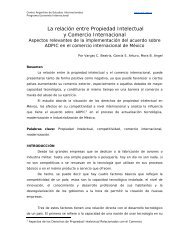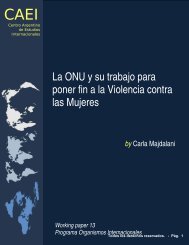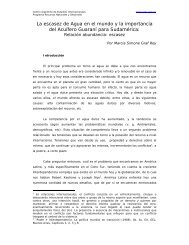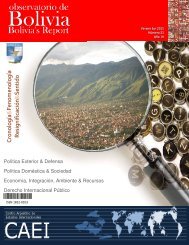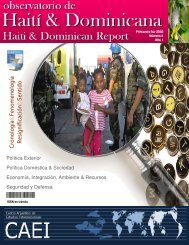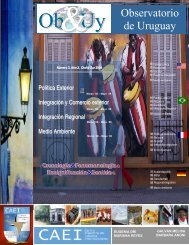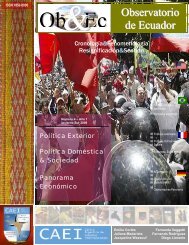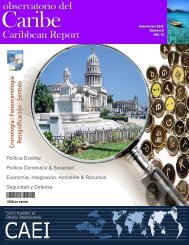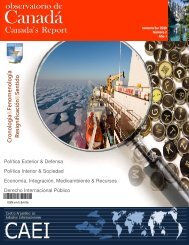An Ottoman Occidentalist in Central Asia: Mehmet Efendi ... - CAEI
An Ottoman Occidentalist in Central Asia: Mehmet Efendi ... - CAEI
An Ottoman Occidentalist in Central Asia: Mehmet Efendi ... - CAEI
Create successful ePaper yourself
Turn your PDF publications into a flip-book with our unique Google optimized e-Paper software.
Centro Argent<strong>in</strong>o de Estudios Internacionales www.caei.com.ar<br />
<strong>An</strong> <strong>Ottoman</strong> <strong>Occidentalist</strong> <strong>in</strong> <strong>Central</strong> <strong>Asia</strong>: <strong>Mehmet</strong> <strong>Efendi</strong><br />
meets the Turkmen Tribes <strong>in</strong> 1877<br />
1<br />
<strong>Mehmet</strong> Fatih Seyhanoglu<br />
Middle Eastern Studies (History) at CUNY<br />
<strong>Ottoman</strong> and Russian relations were very active from the beg<strong>in</strong>n<strong>in</strong>g of the 18th<br />
century to the end of the 19th century due to a number of pressures. On July 21 st ,<br />
1718, follow<strong>in</strong>g the agreement of Pasarofca, while the <strong>Ottoman</strong>s were at war with the<br />
Safavid <strong>in</strong> the east 1 , the Russians began occupation of the western shore of the<br />
Caspian Sea and from there, they wanted to come down from north to south. They<br />
also occupied Baku, a situation that made Russian and <strong>Ottoman</strong> relations very<br />
sensitive and explosive, beg<strong>in</strong>n<strong>in</strong>g on July 24 th , 1724. Although they signed the<br />
agreement of Mukasem-Namisi 2 , it did not m<strong>in</strong>imize the tension escalat<strong>in</strong>g between<br />
them. In 1733, Nadir Ali suddenly attacked and defeated the <strong>Ottoman</strong> governor<br />
Memis Pasha at Ak-Derbend. What is more, he killed Sadrazam Halil Pasha <strong>in</strong><br />
Kerkuk(city). By 1734, he had surrounded Bagdhad. In order to lighten Nadir Ali’s<br />
attacks on the city and draw his attention north, the <strong>Ottoman</strong> Sultan Mahmut Istarted<br />
prepar<strong>in</strong>g for war <strong>in</strong> the Kars area. He appo<strong>in</strong>ted the Kopruluzade Fazil Mustafa Pasha<br />
as a governor of <strong>An</strong>atolia and m<strong>in</strong>ister of war <strong>in</strong> Kars. Moreover, he ordered the Khan<br />
of Crimea, Kaplan Giray, to br<strong>in</strong>g his army to the region of Azerbaijan. The passage of<br />
the Crimean army through the Caucasus to reach Azerbaijan resulted <strong>in</strong> a very<br />
aggressive Russian policy aga<strong>in</strong>st the <strong>Ottoman</strong>s. Firstly, Russia protested <strong>Ottoman</strong><br />
Empire. Russia’s M<strong>in</strong>ister of War, Levasav, and Fatih Giray’s armies confronted each<br />
other a few times. 3 Then Abdullah Pasha was killed by an Iranian <strong>in</strong> 1735, because<br />
the <strong>Ottoman</strong> Empire was deal<strong>in</strong>g with an Iranian war that was not f<strong>in</strong>ished yet. The<br />
<strong>Ottoman</strong> Empire did not want to go war with Russia due to this previous costly and<br />
extended conflict. They asked the Khan of Crimea to pull his army out of the<br />
Caucasus. However, these precautions did not prevent the <strong>Ottoman</strong>-Russian War from<br />
break<strong>in</strong>g out <strong>in</strong> 1736. 4<br />
The war lasted from 1736-1739, end<strong>in</strong>g with the sign<strong>in</strong>g of the Belgrade Agreement <strong>in</strong><br />
1<br />
Uzunçars<br />
172-182<br />
ılı, I smail Hakkı, Osmanlı tarihi (<strong>An</strong>kara: Türk Tarih Kurumu Basımevi, 1949),<br />
2<br />
Aktepe, M. Münir, Osmanlı-Iran Münasebetleri, 1720-1724 ve Silâhsör Kemanî Mustafa<br />
Ag a nın Revan Fetihnamesi (Istanbul: Edebiyat Fakültesi Yay<strong>in</strong>lari, 1970), 15<br />
3<br />
Halim Giray Sultan, Gülbün-i hânân (Erzurum: Fen-Edebiyat Fakültesi, 1990), 142<br />
4 Ibid. , 172
Centro Argent<strong>in</strong>o de Estudios Internacionales www.caei.com.ar<br />
1739. Follow<strong>in</strong>g this agreement, <strong>Ottoman</strong> sent <strong>Mehmet</strong> Emni Beyefendi to Russia as<br />
an ambassador. There were two important factors that led up to the <strong>Ottoman</strong>-Russian<br />
War. First was a contest over the crown <strong>in</strong> Lehistan(Poland). The second reason was<br />
the Crimean army’s desire to pass through Kabartay territory before arriv<strong>in</strong>g <strong>in</strong> the<br />
Caucasus. Kabartay has been west and east of north Caucasus and ruled by the<br />
<strong>Ottoman</strong>s through the Crimean Khan until the beg<strong>in</strong>n<strong>in</strong>g of the 18-century when<br />
Russia took it over. 5<br />
that:<br />
Ivan III sent a letter to the <strong>Ottoman</strong> Sultan Mahmud I <strong>in</strong> 1740. Ivan po<strong>in</strong>ts<br />
“ With the permission of God, I am the emperor of Russia, tsar of Moskoviay,<br />
Kiyoviya, Viladimirya, Novoagrodiya, Kazan, Ejderhan and Siberia. I am ruler<br />
and owner of Peskovya, Ismolenkya, Islandiya, F<strong>in</strong>land, Karliya, Pogarya,<br />
Parmiya, Viyanga, Polgorya. Moreover, I am k<strong>in</strong>g of the land below Novograd,<br />
Cernekovya, Razanya, Rostovya, Kabardiya, Cerakise and leader of mounta<strong>in</strong>s<br />
thorough <strong>in</strong>heritance. To the very respected Sultan Mahmud I, that he is k<strong>in</strong>g<br />
of Med<strong>in</strong>a and Mecca and protector of Jerusalem (Kudus), Rumeli, <strong>An</strong>atolia,<br />
and the Mediterranean and Black Sea. I would like to <strong>in</strong>form you that the<br />
empress of Russia, <strong>An</strong>na Ivanovna, Czar<strong>in</strong>a of Moskoviay, Kiyoviya,<br />
Viladimirya, Novoagrodiya, Kazan, Ejderhan and Siberia. In addition, ruler and<br />
owner of Peskovya, Ismolenkya, Islandiya, F<strong>in</strong>land, Karliya, Pogarya, Parmiya,<br />
Viyanga, Polgorya. Moreover, queen of the land below of Novograd,<br />
Cernekovya, Razanya, Rostovya, Kabardiya, Cerakise and leaders of<br />
mounta<strong>in</strong>s has passed away.” 6<br />
Ivan III with his letter wanted to <strong>in</strong>form the <strong>Ottoman</strong> Sultan of the death of<br />
<strong>An</strong>na Ivanovna and the change <strong>in</strong> adm<strong>in</strong>istration at the Russian court. He def<strong>in</strong>ed<br />
himself as k<strong>in</strong>g of Moskoviay, Kiyoviya, Viladimirya, Novoagrodiya, Kazan, Ejderhan,<br />
Siberia, Peskovya, Ismolenkya, Islandiya, F<strong>in</strong>land, Karliya, Pogarya, Parmiya,<br />
Viyanga, Polgorya and the land below of Novograd, Cernekovya, Razanya, Rostovya,<br />
Kabardiya, and Cerakise. This declaration of power excluded the <strong>Ottoman</strong> Sultan from<br />
power over <strong>Central</strong> <strong>Asia</strong> and the Caucasian area. Ivan III restricted the <strong>Ottoman</strong><br />
Sultan’s power and authority to the areas of the Med<strong>in</strong>a, Mecca, Jerusalem (Kudus),<br />
5 Ferazizade <strong>Mehmet</strong> Said, Gulsen-I Ma’arif (Istanbul: 1740) volume II, 1157-1166<br />
6 This letter bear<strong>in</strong>g the name of Ivan III was sent to the <strong>Ottoman</strong> Sultan Mahmut I <strong>in</strong> 1740.<br />
Prime m<strong>in</strong>ister Archive (Basbakanlik Arsivi), Name-I Humayun Defteri, number. 8, p. 35-37<br />
2
Centro Argent<strong>in</strong>o de Estudios Internacionales www.caei.com.ar<br />
Rumeli, <strong>An</strong>atolia, and the Mediterranean and Black Seas. It seems that he was us<strong>in</strong>g<br />
diplomatic language aga<strong>in</strong>st the <strong>Ottoman</strong> Sultan to imply that the <strong>Ottoman</strong> Sultan<br />
should not dare to <strong>in</strong>volve himself <strong>in</strong> the power structures of <strong>Central</strong> <strong>Asia</strong> and the<br />
Caucasus. In return, equally diplomatically, the <strong>Ottoman</strong> Sultan never used any<br />
geographic terms or specific place names when he wrote to Ivan III, rather he used a<br />
general and abstract word say<strong>in</strong>g, “My grand friend Ivan III, who is still the emperor<br />
of Russia.” 7<br />
Nonetheless, the <strong>Ottoman</strong> adm<strong>in</strong>istration did give up on their struggle aga<strong>in</strong>st<br />
Russia. <strong>Mehmet</strong> Em<strong>in</strong> <strong>Efendi</strong>’s presence at the Russian court is proof of this, show<strong>in</strong>g<br />
that the <strong>Ottoman</strong> Empire had changed their position from a defensive policy to an<br />
active policy by send<strong>in</strong>g an emissary to seek out <strong>Ottoman</strong> <strong>in</strong>terests and provide<br />
<strong>in</strong>formation for its political, economic and military superiority.<br />
A Trip to <strong>Central</strong> <strong>Asia</strong> from Istanbul<br />
Today, we do not have enough <strong>in</strong>formation about <strong>Mehmet</strong> Em<strong>in</strong> <strong>Efendi</strong> 8 . In his<br />
book, he stated that his family and tribe were known <strong>in</strong> Turkistan. He graduated from<br />
school <strong>in</strong> Istanbul. He wanted to be a soldier, but because of a health condition and<br />
physical excuse was not eligible to be <strong>in</strong> the military. He decided be a pen pusher<br />
<strong>in</strong>stead. He said that: “ I can not put up with difficulty. I have no patience and I<br />
cannot deal with stress. Therefore, I do not want to work for the rest of my life as a<br />
pen pusher.” Thus, he decided to travel from mounta<strong>in</strong> to mounta<strong>in</strong> and from savanna<br />
to savanna <strong>in</strong> an attempt to overcome his unhapp<strong>in</strong>ess. He divided his life <strong>in</strong>to three<br />
periods, marked by symbolic discards. First was the removal of his turban cloth, 9<br />
<strong>in</strong>dicat<strong>in</strong>g that he either no longer belonged to the religious clergy or stopped pray<strong>in</strong>g.<br />
Next, he threw out his sword, represent<strong>in</strong>g his <strong>in</strong>ability to soldier due to his physical<br />
condition. Third, he threw away his pen pusher’s pen after he quit that job. At the<br />
end, he “grabbed wand,” consider<strong>in</strong>g the opportunity to travel all around the world. 10<br />
He traveled through most of the European countries, such as France, Germany,<br />
7 Basbakanlik Arsivi, Name-I Humayun Defteri, number. 8, p. 78-79<br />
8 This book was first published <strong>in</strong> 1878. It was published aga<strong>in</strong> <strong>in</strong> 1989. <strong>Mehmet</strong> Em<strong>in</strong> <strong>Efendi</strong>,<br />
Istanbul'dan Asya-yi vustaya seyahat (Istanbul: Kırkanbar Matbaası, 1295[1878]); <strong>Mehmet</strong><br />
Em<strong>in</strong> <strong>Efendi</strong>, Istanbul’dan Orta Asya’ya Seyahat(<strong>An</strong>kara: Kultur ve Turizm Bakanligi, 1986)<br />
9 Sarik: (wrapped around a headpiece to form a turban)<br />
10 <strong>Mehmet</strong> Em<strong>in</strong> <strong>Efendi</strong>, Istanbul'dan Asya-yi vustaya seyahat (Istanbul: Kırkanbar Matbaası,<br />
1295[1878]), 5<br />
3
Centro Argent<strong>in</strong>o de Estudios Internacionales www.caei.com.ar<br />
Russia 11 and Italy. He tried to understand the essence and <strong>in</strong>nermost work<strong>in</strong>gs of<br />
European civilization to prevent the Islamic world from backwardness. He wanted to<br />
understand what made Western civilization superior so that he could use the same<br />
methods to lead a revival of the Islamic world.<br />
<strong>Mehmet</strong> Em<strong>in</strong> <strong>Efendi</strong>’s book, which is entitled “A Travel to <strong>Central</strong> <strong>Asia</strong> from<br />
Istanbul” was published <strong>in</strong> Istanbul <strong>in</strong> 1878. There are many reasons his book is very<br />
important. Ahmet Mithat <strong>Efendi</strong> (1844-1912), a well-known Turkish <strong>in</strong>tellectual and<br />
journalist, wrote a prologue that emphasized the importance of travel books such as<br />
<strong>Efendi</strong>’s to the <strong>Ottoman</strong>s. He says:<br />
“<strong>Ottoman</strong>s did not give importance to travel<strong>in</strong>g. On the other hand,<br />
European travelers journeyed all around the world and they wrote books that<br />
reflected their impression and memoirs. The development of the Islamic world<br />
depends on the guidance of <strong>Ottoman</strong>s, who geographically rema<strong>in</strong>ed <strong>in</strong> the<br />
middle of the Islamic world. Therefore, <strong>Ottoman</strong>s should circulate <strong>in</strong>formation<br />
about new <strong>in</strong>novations and laws of European civilization to the whole Islamic<br />
world. What is more, the <strong>Ottoman</strong>s consider it a a holy mission to follow the<br />
development <strong>in</strong> Europe” 12<br />
Ahmet Mithat <strong>Efendi</strong> argues that people from the <strong>Ottoman</strong> Empire who visited<br />
European countries just saw enterta<strong>in</strong>ment <strong>in</strong> places, as if they traveled from Istanbul<br />
to Beyoglu 13 . In his words, “ If they saw an <strong>in</strong>terest<strong>in</strong>g th<strong>in</strong>g, they would write their<br />
memoirs and impression about it.” 14 He emphasized that there were a couple of<br />
traveler books written that proved that <strong>Ottoman</strong> travelers are rare. He described<br />
<strong>Ottoman</strong> society and people as very static, immobile and had a close relationship with<br />
his environment. He criticized the <strong>Ottoman</strong> lack of <strong>in</strong>terest <strong>in</strong> travel for both economic<br />
and political reasons.<br />
“Until now, we did not give priority to our political <strong>in</strong>terest but 100<br />
ships and 1000 explorers traveled all around the world to extend their territory<br />
from England, Holland, Portugal, Spa<strong>in</strong>, France, Sweden and Norway. For<br />
example, Brita<strong>in</strong> is rul<strong>in</strong>g a territory that is 7-8 times larger than their<br />
population. On the other hand, the <strong>Ottoman</strong>s are sleep<strong>in</strong>g on the bed of<br />
11<br />
He perceived Russia as a European country that he did not take consider geographical but he<br />
considered them culturally close.<br />
12<br />
Ibid. , 6<br />
13<br />
Beyoglu is a district that was outside of the <strong>Ottoman</strong> castle non- Muslims and their embassy<br />
and enterta<strong>in</strong>ment place were base <strong>in</strong> dur<strong>in</strong>g the 19-century.<br />
14<br />
Ibid.<br />
4
Centro Argent<strong>in</strong>o de Estudios Internacionales www.caei.com.ar<br />
unawareness.” 15<br />
The <strong>Ottoman</strong>s did not only seek their <strong>in</strong>terests <strong>in</strong> far away countries but also <strong>in</strong><br />
the members of Islamic countries like Algeria, Morocco, Caucasus, Iran and Arabia.<br />
Unfortunately, they did not pay attention their <strong>in</strong>terest through travel<strong>in</strong>g <strong>in</strong>stead they<br />
were <strong>in</strong>vest<strong>in</strong>g a lot of money build<strong>in</strong>g palace that can easily destroyed by fire <strong>in</strong> two<br />
hours. <strong>Ottoman</strong>s should focus on long-term economic <strong>in</strong>vestment. Therefore, they<br />
should give up perceiv<strong>in</strong>g travel<strong>in</strong>g as a burden! Travel<strong>in</strong>g is great pleasure that<br />
nobody compared it with anyth<strong>in</strong>g else <strong>in</strong> this world. Ahmet Mithat <strong>Efendi</strong> was most<br />
known Turkish <strong>in</strong>tellectual who dedicated his life mak<strong>in</strong>g progressive of Turkish<br />
society stressed importance of political, economic dimension of traveler for the<br />
<strong>Ottoman</strong>s. 16 With the word of Ahmet Mithat <strong>Efendi</strong> 17 ,<br />
“ All world knows that orig<strong>in</strong>s of the <strong>Ottoman</strong>s stems from <strong>Central</strong> <strong>Asia</strong>. But<br />
the <strong>Ottoman</strong>s do not have enough knowledge about <strong>Central</strong> <strong>Asia</strong> yet. French<br />
called their motherland as a “mon patrie” that for the <strong>Ottoman</strong>s are <strong>Central</strong><br />
<strong>Asia</strong>. Known lands of the <strong>Ottoman</strong>s are spiritual extensions of <strong>Central</strong> <strong>Asia</strong>”<br />
In 1877, <strong>Mehmet</strong> Em<strong>in</strong> <strong>Efendi</strong> started his travel from Istanbul 18 while the<br />
<strong>Ottoman</strong>s and Russians were prepar<strong>in</strong>g to declare war aga<strong>in</strong>st each other. There are<br />
many reasons that this trip is very important. <strong>Mehmet</strong> <strong>Efendi</strong> gathered <strong>in</strong>formation<br />
about the Turkmen tribes <strong>in</strong> look<strong>in</strong>g for an alliance and bulwark aga<strong>in</strong>st Russian<br />
Empire <strong>in</strong> the com<strong>in</strong>g conflict. He was us<strong>in</strong>g Islam to mobilize people aga<strong>in</strong>st Russia.<br />
He provided a glut of examples of the cruelty of Russian soldiers aga<strong>in</strong>st Muslim<br />
women and the people of <strong>Central</strong> <strong>Asia</strong>. Moreover, he emphasized the economic<br />
activity and oil revenues, as well as the fertile lands of <strong>Central</strong> <strong>Asia</strong> <strong>in</strong> order to<br />
legitimize war aga<strong>in</strong>st Russia. Iran, Russia and the Dynasty of Bukhara are<br />
characterized as the potential threats <strong>in</strong> the travel book of <strong>Mehmet</strong> <strong>Efendi</strong>. He def<strong>in</strong>ed<br />
Turkmen tribes who fought aga<strong>in</strong>st the Russians as heroes, brand<strong>in</strong>g Turkmen who<br />
collaborated with the Russians as traitors.<br />
After Russia began its rule of rule Baku, it became a very important base. Even<br />
though Vakia Astraha was the most known port of the Caspian Sea, Baku was<br />
15 Ibid.<br />
16 Ibid. , 7<br />
17 Ibid.<br />
18 In his book Dersaadet refers to Istanbul that means gate of happ<strong>in</strong>ess.<br />
5
Centro Argent<strong>in</strong>o de Estudios Internacionales www.caei.com.ar<br />
between Iran and Dagestan. Moreover, it provided a base <strong>in</strong> middle of the south<br />
Caucasus for Russian merchants to transport products through to Iran. Therefore,<br />
Baku will be a very important base <strong>in</strong> the future due to its geographic position.<br />
Moreover, if the Tiflis(Tbilisi) railway connects with Baku, it will empower its location.<br />
Mostly Shii Muslims, Armenian and Russians lived <strong>in</strong> Baku. It has a very w<strong>in</strong>dy<br />
climate. Most of the people have eye illnesses like <strong>in</strong> Egypt. 19 It seems that <strong>Mehmet</strong><br />
Em<strong>in</strong> <strong>Efendi</strong> showed the economic importance of Baku for the Russian and Iranian<br />
market.<br />
City of Krasnovadsk<br />
This region took its name from the river of Kizil (red) Su (water) that was<br />
named by the Turkmen. After the Russians arrived <strong>in</strong> the region, they translated the<br />
city’s name as Krasnovadsk, which means red water <strong>in</strong> Russa<strong>in</strong>. In addition, before<br />
the Russians came to the region, the orig<strong>in</strong>al name of the city was “ Sah-Kadem”.<br />
There were 40-50 stores and a few house existed <strong>in</strong> the area. Russians made a<br />
dist<strong>in</strong>ct effort to <strong>in</strong>crease prosperity <strong>in</strong> the city. 20 Particularly, Krasnovadsk was very<br />
important place for the Russians because they wanted to use it as a military base <strong>in</strong><br />
order to dom<strong>in</strong>ate the Turkmen tribes. A sharp and high cliff surrounded the city.<br />
They got water from wells that were very salty for Russians. Therefore, they tried to<br />
ref<strong>in</strong>e the seawater. He po<strong>in</strong>ted out that he found very important <strong>in</strong>formation as to<br />
how the Russians conquered the region. In 1717-1737, Devlet Girey, who was Muslim<br />
at the beg<strong>in</strong>n<strong>in</strong>g, after he converted to Orthodox Christianity started to work as an<br />
agent of the Russian Empire <strong>in</strong> this area. He came to Sah-Kademor or Krasnovadsk,<br />
and made alliance with the Turkmen for Russia. At the beg<strong>in</strong>n<strong>in</strong>g, he was able to<br />
persuade some of Turkmen tribes that he took under control to follow him on the road<br />
between Krasnovadsk and Hiyve. When he entered the Hiyve, these Turkmen resisted<br />
aga<strong>in</strong>st him. In the long run he failed to succeed aga<strong>in</strong>st the Turkmen. In the end he<br />
lost his all armies <strong>in</strong> the conflict. 21 After a while, Russia understood that it was<br />
impossible to w<strong>in</strong> a war aga<strong>in</strong>st Turkmen <strong>in</strong> the desert. Therefore, the Russians<br />
decided f<strong>in</strong>d alliances for themselves. They began to br<strong>in</strong>g presents to Turkmen<br />
leaders when they visited them. In the end, they were able to conquer Asur Island on<br />
the Caspian Sea from Iran, which they then used as a military base for their navy. As<br />
a result, Russia easily controlled Iranian and Turkish shorel<strong>in</strong>es through Asur Island.<br />
Russia did not create alliances with Turkmen directly. They appo<strong>in</strong>ted army officer<br />
19 Ibid. , 16-17<br />
20 Ibid. , 17.<br />
21 Ibid. , 18<br />
6
Centro Argent<strong>in</strong>o de Estudios Internacionales www.caei.com.ar<br />
Derya Begi to create alliances for them. His duty strengthened Russia’s ties with the<br />
Turkmen tribes. He made Turkmen who lived <strong>in</strong> Hasan Kuli and Gumustepe. 22 <strong>Mehmet</strong><br />
Em<strong>in</strong> <strong>Efendi</strong> narrates the Russian colonization of <strong>Central</strong> <strong>Asia</strong> and the Caucasus. The<br />
way he represented Russian colonization processes showed that the <strong>Ottoman</strong>s shared<br />
the same religion with Turkmen,and that the <strong>Ottoman</strong>s could create alliance much<br />
more easily than the Russians.<br />
He described Russia’s military officer, Siviston, who had an ignorant,<br />
corrupted, selfish, arrogance, aggressive personality that used violence aga<strong>in</strong>st<br />
Krosnovods people. Turkmen not only compla<strong>in</strong>ed about Siviston but also Iranian and<br />
Armenian officers. They were fed up with his behavior and his decisions. <strong>Mehmet</strong><br />
<strong>Efendi</strong> accused him of be<strong>in</strong>g a rapist. He tried hav<strong>in</strong>g relations with Turkmen women<br />
aga<strong>in</strong>st their will. Moreover, they started take children of Turkmen tribes leader to<br />
sent Moscow for education. 23 Most Turkmen moved from Krasnovadsk <strong>in</strong> order to save<br />
their honour. 24<br />
<strong>Ottoman</strong> traveler <strong>Mehmet</strong> Em<strong>in</strong> <strong>Efendi</strong> argues that Turkmen perceived Iranian<br />
as enemies. In one of their songs, they repeat Koroglu’s name, tell<strong>in</strong>g how he was<br />
very successful aga<strong>in</strong>st the Iranians. They compare an Iranian coward to a women,<br />
s<strong>in</strong>g<strong>in</strong>g of how Koroglu dispersed the Iranian army and shook the throne of the<br />
Iranian Shah. 25 <strong>Mehmet</strong> Em<strong>in</strong> <strong>Efendi</strong> mentioned the positive and good behavior of<br />
Turkmen. However, he also harshly criticized them at times, such as when one of his<br />
guides that Rahmanverdi robbed food dur<strong>in</strong>g their trip <strong>in</strong> desert. In this he shows that<br />
he is an accurate and impartial chronicler of these people. 26<br />
<strong>Efendi</strong> dreamt of unity between the 200 million Muslims <strong>in</strong> the <strong>Asia</strong> when he<br />
traveled <strong>in</strong> this region. His hope grew while he was <strong>in</strong> <strong>Asia</strong>. 27 When Nurverdi Khan,<br />
the Teke Turkmen tribe leader, heard <strong>Mehmet</strong> Em<strong>in</strong> <strong>Efendi</strong> was a citizen of the<br />
<strong>Ottoman</strong> Empire, he showed him more respect. Nurverdi Khan was very brave person<br />
who won a war aga<strong>in</strong>st Iran, Buhara and Russia. Particularly, he destroyed the Iranian<br />
army and kept their gunpowder at Merv castle. 28 Even though he won lat of war<br />
aga<strong>in</strong>st Russia. He told <strong>Mehmet</strong> <strong>Efendi</strong> that whoever lives <strong>in</strong> Istanbul should try to<br />
unify the Turkmen. It was difficult for him to unify Turkmen aga<strong>in</strong>st Russia. There<br />
22 Ibid. , 19<br />
23 Ibid. , 43.<br />
24 Ibid. , 40-41<br />
25 Ibid. , 72<br />
26 Ibid. ,91<br />
27 Ibid. , 90<br />
28 Ibid. , 94<br />
7
Centro Argent<strong>in</strong>o de Estudios Internacionales www.caei.com.ar<br />
were a lot of disputes between Turkmen. 29 This made <strong>Efendi</strong> more <strong>in</strong>cl<strong>in</strong>ed to like<br />
Nurverdi Khan, enough so that he made him a gift of a handgun made <strong>in</strong> Brita<strong>in</strong>.<br />
Nurverdi Khan replied with an Arab horse, and <strong>Efendi</strong> is clearly touched by the<br />
gesture, expla<strong>in</strong><strong>in</strong>g how they became next world brothers through this exchange. 30<br />
Iran- Brita<strong>in</strong> and the <strong>Ottoman</strong> representatives meet Turkmen <strong>in</strong> Iran<br />
Father of <strong>Mehmet</strong> Em<strong>in</strong> <strong>Efendi</strong>’s guide, he went to with <strong>Mehmet</strong> Em<strong>in</strong> Khan and<br />
his ambassador Ates Muharem to Tehran. They had a meet<strong>in</strong>g with the Iranian Shah,<br />
British and <strong>Ottoman</strong> representatives. Accord<strong>in</strong>g to the Iranian tradition, when you see<br />
the Shah, you must prostrate yourself and glorify the Shah. However, he did not do it<br />
because he told them he only prostrates God. The <strong>Ottoman</strong> traveler appreciated his<br />
behavior aga<strong>in</strong>st the Shah. Ates Muharrem and the <strong>Ottoman</strong> representative had a talk<br />
on mak<strong>in</strong>g Hiyve part of <strong>Ottoman</strong> territory. But it was unrealistic because Hiyve does<br />
not have connection with <strong>Ottoman</strong> territory. 31 Whereupon, the <strong>Ottoman</strong><br />
representative suggested that all of the Maveraunnehir dynasty should unify their<br />
power. Ates Muharrem responded, “There is no possibility for Hiyve and Kokland<br />
jo<strong>in</strong><strong>in</strong>g together because the selfishness and arrogance of the Khan of Bukhara makes<br />
unity impossible,” 32 and then <strong>Ottoman</strong> representative asserted that Hiyve and Hokand<br />
must force Bukhara for Unity. 33<br />
<strong>Mehmet</strong> Em<strong>in</strong> <strong>Efendi</strong>’s Impression of Hiyve<br />
<strong>Mehmet</strong> Em<strong>in</strong> <strong>Efendi</strong> stayed <strong>in</strong> Hiyve two days and then he decided to go to<br />
Taskent. He <strong>in</strong>formed “Divan Beyi” of his decision, but was told that the Khan of Hiyve<br />
wanted him to stay for circumcision wedd<strong>in</strong>g of Hiyve Khan’s children or Shahzade.<br />
He decided to stay <strong>in</strong> Hiyve. There were 500 hundreds important tradesmen and<br />
Hiyve’s people gathered <strong>in</strong> the one of the gardens of the Hiyve Khan. They were very<br />
quiet and very respectful to <strong>Mehmet</strong> Em<strong>in</strong> <strong>Efendi</strong>, so he felt very good. However, 30<br />
m<strong>in</strong>ute later a young and well-dressed man appeared <strong>in</strong> the garden with two men.<br />
Suddenly, all of the people stood up and showed him their respect. 34 They crossed<br />
their arms over their chests. They showed him the best place <strong>in</strong> garden to sit. He<br />
turned to <strong>Efendi</strong>, asked “How are you?” and <strong>Mehmet</strong> <strong>Efendi</strong> stood up respectfully and<br />
29 Ibid. , 103<br />
30 That means they will meet <strong>in</strong> next world.<br />
31 Ibid. , 117<br />
32 Ibid. , 118<br />
33 Ibid.<br />
34 Ibid. , 135<br />
8
Centro Argent<strong>in</strong>o de Estudios Internacionales www.caei.com.ar<br />
answered him, “Kulluk” mean<strong>in</strong>g ‘I am your slave.’ <strong>An</strong>d then people who were around<br />
him smiled to <strong>Mehmet</strong> <strong>Efendi</strong> that he felt that he made mistake. It was a custom to<br />
br<strong>in</strong>g guest food. Therefore, they brought him food as like as they had brought it to<br />
<strong>Efendi</strong> earlier. He ate it and then they served him tea. He filled his teacup. “I thought<br />
it was shame and disrespectful behavior that young and well dressed man that filled<br />
his own teacup.” 35 <strong>Mehmet</strong> <strong>Efendi</strong> thought that he was a very important person. He<br />
was sure that the young man was the child of Hiyve Khan. Someone else should fill<br />
his teacup. After he drank his tea, he offered <strong>Efendi</strong> a dr<strong>in</strong>k of tea from his cup. He<br />
drank it <strong>in</strong> order to show the young man his respect. Aga<strong>in</strong> people smiled at effendi,<br />
and he felt very shy. He did not return his cup. Later, the young man po<strong>in</strong>ted at the<br />
man offered tea. He stood up and then he crossed his arms over his chest to show his<br />
respect and said to him ‘I would be your slave’. After he drank it he returned the<br />
teacup. Later, two men showed up, took him and made him wear women’s cloth<strong>in</strong>g<br />
beside they played Saz (A long-necked Turkish lute <strong>in</strong> the Baglama family) and<br />
Tambour. He emphasized that Homosexuals had very important prestige <strong>in</strong> Turkmen<br />
culture. 36 Most Turkmen brought Köçek (formerly youth who performed erotic dances<br />
<strong>in</strong> woman's garb) for danc<strong>in</strong>g <strong>in</strong> their wedd<strong>in</strong>g. Every street, tea place, bazaar had<br />
one Köçek <strong>in</strong> order to enterta<strong>in</strong> and served people (Erbabi Keyf). People gave them a<br />
lot of compliments. For Example, they said ‘I scarified myself for you, I would like to<br />
sp<strong>in</strong> you like a propeller.’ <strong>Mehmet</strong> Em<strong>in</strong> <strong>Efendi</strong> argues that Homosexuality orig<strong>in</strong>ated<br />
from Iranian rather than Turkmen culture. He said that: “ I am sure that this bed<br />
custom transmitted from Iranian to Turkmen” 37 The dancer played very well and<br />
people spilled money over him. The dancer man lay down on his back <strong>in</strong> order to<br />
gather money with his teeth from ground. They watched him dance until the sun went<br />
down. They distributed candy and Corek(a round, braided cookie or bread roll) that<br />
signifies a circumcision wedd<strong>in</strong>g’s end with read<strong>in</strong>g Fatiha (a verse from Qur’an). 38<br />
People put their present at their waistband s<strong>in</strong>ce they don’t have pocket at<br />
their pants (Don). Women wore th<strong>in</strong> and very yummy fabric pants thats front sides<br />
are made very strong and backsides are made of very weak cloth. They wore sharp<br />
and long th<strong>in</strong>gs on their head that they called Tepelik. When they <strong>in</strong>tended to go<br />
market they wore Tepelik <strong>in</strong> order to seem taller. In addition to Tepelik, they wore<br />
headscarves <strong>in</strong> the market. Hiyve’s women pierced their noses and wore hoops <strong>in</strong><br />
35 Ibid. , 136<br />
36 Ibid. , 136<br />
37 Ibid. , 137.<br />
38 Ibid.<br />
9
Centro Argent<strong>in</strong>o de Estudios Internacionales www.caei.com.ar<br />
them. Hiyve’s houses architecture was build Baghdadi style and so did do not have<br />
w<strong>in</strong>dows on the street side. They had w<strong>in</strong>dows at the middle of their houses that<br />
looked out toward a courtyard. They had Haremlik and Selamlik, which are portions of<br />
a house reserved for women and men. They covered their roof with terra<strong>in</strong> that<br />
showed they don’t know about roof tile. Their houses were made of sun-dried bricks<br />
(Kerpic). They drew very nice figures and graven at theirs doors and walls. 39<br />
The Adm<strong>in</strong>istrative Structure of Hiyve<br />
At the beg<strong>in</strong>n<strong>in</strong>g there was no central authority <strong>in</strong> Hiyve. The feudal lords were<br />
dom<strong>in</strong>ant. However, Seyid <strong>Mehmet</strong> Khan united all feudal lords and tribes us<strong>in</strong>g<br />
violence aga<strong>in</strong>st some tribes and persuasion on therest of them. As a result, he<br />
became dom<strong>in</strong>ant and decision makers of Hiyve. Khan was a member of the<br />
“Kongirat” tribe that was one of four important Uzbek tribes. “Nakip” and “Hoca<br />
Kelan” participated Khan’s Divan <strong>in</strong> official day, which meet<strong>in</strong>gs started every mid-<br />
afternoon. Sometimes Khan and his officers listened to people compla<strong>in</strong> and tried to<br />
solve their problems. When Khan didn’t attend meet<strong>in</strong>gs “Reis-ul Umera” represented<br />
him and made decision <strong>in</strong> his name. Leaders of Uzbek tribes had superiority and<br />
privilege over other tribes. Moreover, Khan’s Tribe, Kangirat tribe, had more privileges<br />
than the other three Uzbek tribes.<br />
Khan’s adm<strong>in</strong>istrative structure was comprised of the three ma<strong>in</strong><br />
adm<strong>in</strong>istrative positions that were mentioned above. In addition to this, each tribe has<br />
8 adm<strong>in</strong>istrative titles that represented its tribe <strong>in</strong> front of Khan.<br />
Inak has four members. 2 of the members had to be very close relative<br />
of Khan. Other 2 members selected <strong>in</strong> the Khan’s tribe.<br />
Atalik: Fatherl<strong>in</strong>ess<br />
Seyhulislam: is charge religious ceremony that has close ties with<br />
prophet.<br />
Fermanecisi: person who handles matters of protocol, protocol officer<br />
Beg: tribe’s nobleman<br />
Mirab: person who is responsible for water and conduit.<br />
Darugasi: playful of Khan.<br />
Agasi: footmen of door.<br />
The Grand Vizier was chosen from the Sart tribe. Kusbegi(Second vizir) was<br />
chosen from Uzbek. They collected taxes. Divan Begi(head of council) was the<br />
39 Ibid. , 138<br />
10
Centro Argent<strong>in</strong>o de Estudios Internacionales www.caei.com.ar<br />
assistant of Khan as a chief secretary and custom m<strong>in</strong>ister that “Divan Begi” had two<br />
“Yasavul Basi” that their duty look liked Zaptiah or police. In addition, they had 8<br />
more “Esik Agasi” that were servants. 40 Military adm<strong>in</strong>istration was composed of two<br />
major commanders and four-brigade and gunpowder and 2-3 capta<strong>in</strong>s. In addition,<br />
Khan had officers named Mirseb, Mabey<strong>in</strong>ci, Esvabci Basi, Haz<strong>in</strong>ei Hassa Naziri. They<br />
weren’t paid by Khan. Khan gave the revenue of town, village and city to them.<br />
<strong>Mehmet</strong> Em<strong>in</strong> <strong>Efendi</strong> po<strong>in</strong>ts that they were all corrupt. In addition these revenues,<br />
Khan distributed horses and money to the officers. Islamic law was practiced <strong>in</strong> Hiyve.<br />
However, they threw crim<strong>in</strong>als from the m<strong>in</strong>arets of mosques to the ground.<br />
Moreover, they tied crim<strong>in</strong>als to fireworks dispers<strong>in</strong>g his body with gunpowder. He<br />
argues that they acted very wildly. 41<br />
Conclusion<br />
<strong>Mehmet</strong> Em<strong>in</strong> <strong>Efendi</strong> tried to save the <strong>Ottoman</strong>s from military defeat aga<strong>in</strong>st<br />
Russia. Therefore, he traveled from Istanbul to <strong>Central</strong> <strong>Asia</strong> to f<strong>in</strong>d alliances for<br />
<strong>Ottoman</strong>s and provide Islamic unity. There is a similarity between European travelers<br />
and his writ<strong>in</strong>g <strong>in</strong> his use of detailed travel records that served to expand the political<br />
and economic th<strong>in</strong>k<strong>in</strong>g of the leaders of his home nation. His writ<strong>in</strong>g and efforts to<br />
describe the Islamic people of <strong>Central</strong> <strong>Asia</strong> and the Caucasus revealed a group of<br />
people whose similarity to the <strong>Ottoman</strong> Empire’s people was cause enough to extend<br />
a diplomatic hand <strong>in</strong> an effort to halt the tide of Cyrillic expansion <strong>in</strong>to the area.<br />
Despite its ultimate failure, it was an effort that opened doors and attempted to br<strong>in</strong>g<br />
the <strong>Ottoman</strong> Empire to modernity, a worthy effort <strong>in</strong>deed.<br />
40 Ibid. , 156<br />
41 Ibid. , 157<br />
11





